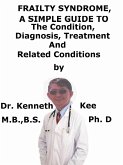Pre-cordial Catch Syndrome (Texidor's Twinge) is a fairly common disorder that most often appears in children and adolescents.
Pre-cordial catch syndrome, also termed Texidor's twinge, is featured by sharp stabbing pains on the left side of the chest that appears suddenly and just as quickly disappears.
The chest pain happens when nerves in the front of the chest are compressed or stimulated.
The chest pain does not persist long and normally fades away on its own.
It is a form of chest pain that happens when the nerves in the front part of the chest are irritated.
It may appear serious but normally it does not produce any harm.
Pre-cordial catch syndrome in adults is less frequent.
Pre-cordial catch syndrome pain is so common that it is easily noticed by caregivers and doctors.
Painful attacks become less frequent and less intense as the patients grow older to their 20's.
Pre-cordial catch syndrome may happen at any age but often happens in children aged 6 to 12 years.
There is no predilection between male and female sexes or between races.
The chest pain normally happens while the patient is at rest and never happens during sleep.
It has no temporal link with meals or eating.
It is not always clear what activates pre-cordial catch syndrome but it is not produced by a heart or lung disorder.
Some doctors believe that the chest pain is probably due to irritation of the nerves in the lining of the lung, also termed the pleura.
Others believe that pain from the ribs or cartilage in the chest wall may also be the cause.
The nerves could be aggravated by poor posture to an injury such as a blow to the chest.
While doctors do not identify precisely what causes pre-cordial catch syndrome, they believe poor posture leading to muscle spasms may be a contributing cause.
Many people feel the pain when they are inactive watching television while sitting in the lounge or when they are slouching or bending over.
A growth spurt could even activate some pain in the chest.
Other people develop symptoms of pre-cordial catch syndrome during times of stress or anxiety
Children with pre-cordial catch syndrome note the pain normally had these characteristics:
Made worse by breathing
Short
Sudden
Sharp
Non-spreading
Not exertion-related
It may happen more than once a day and normally fades away suddenly.
If the diagnosis is pre-cordial catch syndrome, there is no specific treatment required.
Specific treatment is normally not necessary since the pain normally fades away on its own.
Correction of the posture and slow breathing may assist to reduce the pain.
Muscle spasms resulting from poor posture may play a role in causing the chest pain.
Occasionally slow, gentle breaths can assist the chest pain to resolve.
In some cases, a deep breath or 2 may relieve the pain, though those breaths may be painful.
Since poor posture may activate pre-cordial catch syndrome, sitting up with a straight back may help stop future episodes.
If such chest pain happens to a patient, the doctor will first exclude other serious causes of the pain such as heart or lung diseases by taking a full medical history and conducting a full examination.
The doctor should encourage the child to play outdoor games besides indoor ones.
Walking, physical exercise, deep breathing and relaxation methods are good ways to treat the symptoms.
TABLE OF CONTENT
Introduction
Chapter 1 Pre-cordial Catch Syndrome (Texidor's Twinge)
Chapter 2 Causes
Chapter 3 Symptoms
Chapter 4 Diagnosis
Chapter 5 Treatment
Chapter 6 Prognosi...
Dieser Download kann aus rechtlichen Gründen nur mit Rechnungsadresse in A, B, CY, CZ, D, DK, EW, E, FIN, F, GR, H, IRL, I, LT, L, LR, M, NL, PL, P, R, S, SLO, SK ausgeliefert werden.









